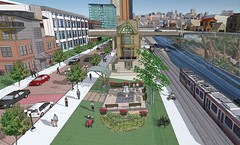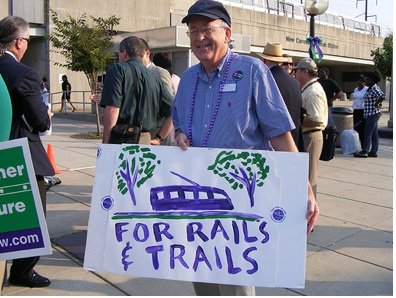Light rail in Baltimore (and Montgomery and Prince George's Counties)
I haven't blogged about Governor O'Malley's recommendation of light rail for both the Purple Line in Montgomery and Prince George's Counties, and the "Red" Line in Baltimore, because these choices were expected. What matters is whether or not the Federal Transit Adminstration funds either or both of them. That decision will happen over the course of the next year.
However, Maryland Politics Watch has an interesting entry, "Single-Tracking is a Terrible Idea – Except When it’s a Good One" about satisficing and data cooking for the Red Line proposal. '
Also see "Despite cheapening the Red Line, the MTA suddenly finds 12,000 new daily riders," "Red Line planning enters bizarro phase" and "Baltimore’s billion-bucks transit shopping spree: how not to blow it: Here are five places where those Red Line dollars could make a dramatic difference – but they’re not in any MTA plans" by Gerald Neilly, in Baltimore Brew.
There are many problems with the proposed routing and other decisions for this line.
On the EnvisionBaltimore elist and in blogs such as Baltimore Innerspace (see "Something Borrowed, Something Red" - A RED LINE PLAN TO HARBOR POINT - AND A DIRECT ROUTE TO COMPRHENSIVE RAIL TRANSIT TO EVERYWHERE) problems with the proposed line have been identified and discussed ad infinitum.
At the same time this discussion has generated a number of interesting alternatives have been proposed as well, such as interesting urban design healing maneuvers, such as the BaltiMorphosis fix of the Franklin-Mulberry "ditch."
To this

From this

through the transformative power of transit done right.
But none of these important ideas are in the plans for the Baltimore Red Line.
Ideally, the line should be conceived in part as a "healing and connecting" operation, designed to foster the creation of a transit network in Baltimore--as Baltimore has a number of disconnected and discoordinated transit assets including a stunted subway line, a single line of light rail, railroad passenger service, and buses.
As Philippe Crist of the Joint Transport Research Centre of the OECD says in his blog entry on World Streets "Letter to America: Some lessons from Europe" with suggestions for U.S. transportation policy
• 2nd Principle: Make places better to live, work, play – This will involve some thinking that involves the communities re. what kind of place they wish their region to be. ...
• Streets support many non-transport uses – So where appropriate, they should be managed and built to facilitate all uses. Caveat – this may not be possible on many US “streets” which are in fact mono-use facilities that may prove very difficult to retrofit. But still, the momentum is gathering in many places.
Where is this kind of thinking for the Baltimore Red Line?
I see the pandering with regard to local hiring decisions, but not enough about fundamental transformation of Baltimore's livability and connectedness through the addition of fixed rail transit.
The irony is that Baltimore already made one disastrous single tracking decision for light rail and then corrected it at great cost a few years ago. Only now are ridership levels getting back to normal.
Making the same mistake twice is unfathomable.
I wonder if it would be best for the Baltimore Red Line to not receive funding approval and for it to be redesigned to achieve a greater number of positive objectives for Baltimore. As currently designed, it is not the transformational transit project that Baltimore needs to begin the difficult process of knitting together its various transit assets into one coordinated and usable system.
------
The interesting thing about the battle over light rail in Montgomery County is that it is about nimbyism. The bus alternatives touted by the Town of Chevy Chase are illogical. And most of the people who claim they care about the trail and loss of trees are using the trail and trees to fight the creation of the light rail line. They probably don't care much about the trail or trees, and drive most everywhere.
Trees grow back--if you plant them and water them. (I say this having grown an 80 foot tree from a 5 inch seedling starting about 34 years ago...).
And yes, while my bonafides about supporting bicycling are strong, the Purple Line won't eliminate the ability to bicycle on the Capital Crescent Trail, not to mention that the light rail line will serve far more people every day. Frankly, it might make bicycling safer and increase use, because there will be more positive activity and reasons to use the trail.

Light Rail in Barcelona. Photo by John Norquist.
Integrating transportation facilities to accommodate bicycling as well as transit and walking answers the opposition. Finish the Trail and other bicycling advocates support the Purple Line, see this blog entry from FtT, "Who speaks for Trail Supporters?" and "O'Malley commits to Purple Line trains" from the Gazette.

Image from Finish the Trail
Labels: change-innovation-transformation, public finance, transit and economic development, transportation planning, urban design/placemaking



0 Comments:
Post a Comment
<< Home